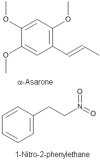Essential Oils and Their Constituents Targeting the GABAergic System and Sodium Channels as Treatment of Neurological Diseases
- PMID: 29724056
- PMCID: PMC6099651
- DOI: 10.3390/molecules23051061
Essential Oils and Their Constituents Targeting the GABAergic System and Sodium Channels as Treatment of Neurological Diseases
Abstract
Essential oils and the constituents in them exhibit different pharmacological activities, such as antinociceptive, anxiolytic-like, and anticonvulsant effects. They are widely applied as a complementary therapy for people with anxiety, insomnia, convulsion, pain, and cognitive deficit symptoms through inhalation, oral administration, and aromatherapy. Recent studies show that essential oils are emerging as a promising source for modulation of the GABAergic system and sodium ion channels. This review summarizes the recent findings regarding the pharmacological properties of essential oils and compounds from the oils and the mechanisms underlying their effects. Specifically, the review focuses on the essential oils and their constituents targeting the GABAergic system and sodium channels, and their antinociceptive, anxiolytic, and anticonvulsant properties. Some constituents target transient receptor potential (TRP) channels to exert analgesic effects. Some components could interact with multiple therapeutic target proteins, for example, inhibit the function of sodium channels and, at the same time, activate GABAA receptors. The review concentrates on perspective compounds that could be better candidates for new drug development in the control of pain and anxiety syndromes.
Keywords: CNS; GABA receptor; analgesics; anticonvulsant; antinociception; anxiolytic; epilepsy; essential oils; pain; sensory neurons; sodium channel; terpenes; transient receptor potential (TRP) channel.
Conflict of interest statement
The authors declare no conflict of interest.
Figures






References
Publication types
MeSH terms
Substances
Grants and funding
LinkOut - more resources
Full Text Sources
Other Literature Sources
Medical

